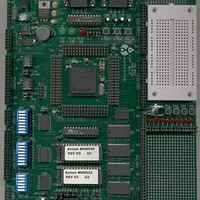MPC555CME Freescale Semiconductor, MPC555CME Datasheet - Page 214

MPC555CME
Manufacturer Part Number
MPC555CME
Description
KIT EVALUATION FOR MPC555
Manufacturer
Freescale Semiconductor
Type
Microcontrollerr
Datasheet
1.MPC555CME.pdf
(966 pages)
Specifications of MPC555CME
Contents
Module Board, Installation Guide, Power Supply, Cable, Software and more
Processor To Be Evaluated
MPC555
Data Bus Width
32 bit
Interface Type
RS-232
For Use With/related Products
MPC555
Lead Free Status / RoHS Status
Contains lead / RoHS non-compliant
- Current page: 214 of 966
- Download datasheet (13Mb)
6.2.2 Address Decoding for External Accesses
6.3 USIU General-Purpose I/O
MPC555
USER’S MANUAL
The external master may access the internal MPC555 / MPC556 special registers that
are located outside the RCPU. In order to access one of these MPC555 / MPC556 reg-
isters, program the EMCR to MPC555 / MPC556 special register access (CONT = 1
and SUPU = 0 in EMCR). Next, access the register by providing the address according
to the MPC555 / MPC556 address map. Only the first external master access that fol-
lows EMCR setting will be assigned to the special register map; the next accesses will
be directed to the normal address map. This is done in order to enable the user to ac-
cess the EMCR again after the required MPC555 / MPC556 special register access.
Peripheral mode does not require external bus arbitration between the external master
and the internal RCPU, since the internal RCPU is disabled. The BR and BB signals
should be connected to ground, and the internal bus arbitration should be selected in
order to prevent the “slave” MPC555 / MPC556 from occupying the external bus. In-
ternal bus arbitration is selected by clearing the EARB bit in the SIUMCR (see
SIU Module Configuration
During an external master access, the USIU compares the external address with the
internal address block to determine if MPC555 / MPC556 operation is required. Since
only 24 of the 32 internal address bits are available on the external bus, the USIU as-
signs zeros to the most significant address bits (ADDR[0:7]).
The address compare sequence can be summarized as follows:
When trying to fetch an MPC555 / MPC556 special register from an external master,
the address might be aliased to one of the external devices on the external bus. If this
device is selected by the MPC555 / MPC556 internal memory controller, this aliasing
does not occur since the chip select is disabled. If the device has its own address de-
coding or is being selected by external logic, this case should be resolved.
The USIU provides 64 general-purpose I/O (SGPIO) pins. The SGPIO pins are multi-
plexed with the address and data pins. In single-chip mode, where communicating with
external devices is not required, the user can use all 64 SGPIO pins. In multiple-chip
mode, only eight SGPIO pins are available. Another configuration allows the use of the
address bus for instruction show cycles while the data bus is dedicated to SGPIO func-
• Normal external access. If the CONT bit in EMCR is cleared, the address is com-
• MPC555 / MPC556 special register external access. If the CONT bit in EMCR is
• Memory controller external access. If the first two comparisons do not match, the
/
pared to the internal address map.
set by the previous external master access, the address is compared to the
MPC555 / MPC556 special address range. See
Map
internal memory controller determines whether the address matches an address
assigned to one of the regions. If it finds a match, the memory controller gener-
ates the appropriate chip select and attribute accordingly
MPC556
for a list of the SPRs in the USIU.
SYSTEM CONFIGURATION AND PROTECTION
Register).
Rev. 15 October 2000
5.4 USIU PowerPC Memory
MOTOROLA
6.13.1.1
6-6
Related parts for MPC555CME
Image
Part Number
Description
Manufacturer
Datasheet
Request
R

Part Number:
Description:
MPC555 Interrupts
Manufacturer:
Freescale Semiconductor / Motorola
Datasheet:
Part Number:
Description:
Manufacturer:
Freescale Semiconductor, Inc
Datasheet:
Part Number:
Description:
Manufacturer:
Freescale Semiconductor, Inc
Datasheet:
Part Number:
Description:
Manufacturer:
Freescale Semiconductor, Inc
Datasheet:
Part Number:
Description:
Manufacturer:
Freescale Semiconductor, Inc
Datasheet:
Part Number:
Description:
Manufacturer:
Freescale Semiconductor, Inc
Datasheet:
Part Number:
Description:
Manufacturer:
Freescale Semiconductor, Inc
Datasheet:
Part Number:
Description:
Manufacturer:
Freescale Semiconductor, Inc
Datasheet:
Part Number:
Description:
Manufacturer:
Freescale Semiconductor, Inc
Datasheet:
Part Number:
Description:
Manufacturer:
Freescale Semiconductor, Inc
Datasheet:
Part Number:
Description:
Manufacturer:
Freescale Semiconductor, Inc
Datasheet:
Part Number:
Description:
Manufacturer:
Freescale Semiconductor, Inc
Datasheet:
Part Number:
Description:
Manufacturer:
Freescale Semiconductor, Inc
Datasheet:
Part Number:
Description:
Manufacturer:
Freescale Semiconductor, Inc
Datasheet:
Part Number:
Description:
Manufacturer:
Freescale Semiconductor, Inc
Datasheet:










